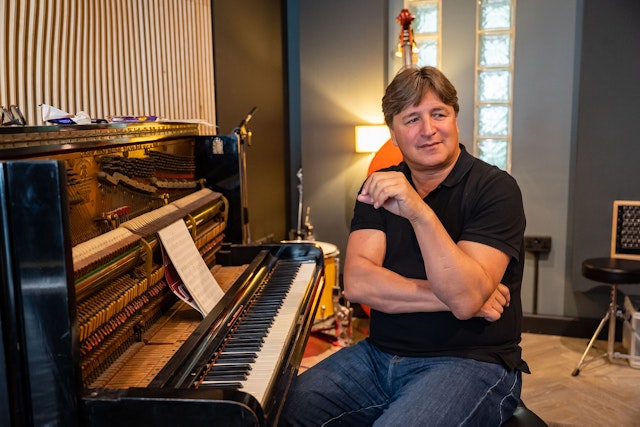‘It was like a Mad Men pitch scene’: Guy Farley on composing Cadbury’s new sonic logo
As part of The Drum’s Audio Deep Dive, we catch up with British composer Guy Farley, who was tasked with capturing chocolate brand Cadbury in sound.
Having been around since 1824 and currently the second-largest confectionery business in the world, Cadbury elicits fond memories for many. This emotional connection was at the core of the brand’s recent foray into audio, with famed film composer Guy Farley the perfect pick for the mammoth job.
“Music has been part of my entire life,“ he tells The Drum. “You can’t really describe music – I was born with it.”
Farley’s career has spanned many years and genres, with work ranging from orchestral scores to world music to contemporary sound design. Earlier this year, a call came from frequent collaborator Sascha Darroch-Davies, the agency partners director at DLMDD, about a new musical logo for Cadbury.
As usual, the pair’s partnership flowed organically but quickly, which Farley describes as ”like a Mad Men pitch scene”. The brief was to ”write a musical motif that captures and encompasses the emotions of Cadbury,” he says, but among the marketing jargon (which Farley says he can take or leave) were two words that really sparked his imagination – ”coming home”.
“That is what struck a chord with me. I went to bed that night and I was asleep, but I heard this thing in my head [Farley hums ’de la dum’]. It’s a bit like an amen – it’s homely.”

In the morning, he went down to his studio and began playing the refrain on his one-of-a-kind 1895 Steinway upright piano. “I didn’t have a click, I didn’t have a metronome. I sat there and I tried different keys. Then I improvised a bit, I made it five notes, three notes, four notes, six notes. I did all these things, but the one they chose was the first three.”
Although he knew deep down that he wanted the antique piano to be the sound of Cadbury, he decided to experiment a little along the way. “I did countless versions of it on instruments like marimbas, glockenspiels and synthesizers from the 80s. With so many different choices for the same theme, [Cadbury] went back to that 1895 Steinway piano.
“From the conversation with Sascha at 6pm, it was written in my head by 8.30am the following morning. It was then played on the piano at home at 8.45am and it was recorded in my studio by 10am.”
Cadbury has begun rolling out its new sonic identity in the UK and Australia. “You know what you’re going to get with Cadbury, you know how it’s going to make you feel,” says Farley. “I wanted to capture that in music.”
Jingles are nothing new, but more and more brands have been investing in audio lately. As Farley puts it: “There is nothing like a musical hook to go with your brand.” It’s no easy task, however, despite how straightforward he makes it seem.
“Sometimes, I feel it’s easier to write a 70-minute film score than it is to write something for 60-seconds – particularly when you get given 12 different adjectives and every adjective needs to be addressed. It’s almost like the art of writing music for Tom and Jerry. You’ve really got to be able to do something that fits perfectly into such a short timeframe.”
So what is Farley’s favorite jingle? “I think the Gordon’s Gin adverts were phenomenal. They were amazing and I love the music.”
Sonic branding will live with a brand for years and Darroch-Davies says the trend he’s seeing “is just more interest and people taking it more seriously”.
“Five years ago, people treated it like a normal campaign brief. But it’s a core brand asset. It’s almost as important as a visual logo now.”
He points to McDonald’s ‘I’m Lovin’ It’, which has now been around for over 20 years, as an audio mnemonic that the majority of people recognize, explaining that “a recent study showed 76% recognition on that asset“. JustEat, meanwhile, got 72% recognition in just four years, he says. “And that’s to do with the fact that you’re saying the brand name. Something that you can repeat is more effective because if you or I can sing it back to people, then suddenly you’ve got free advertising.”
For more on the power of sound, check out The Drum’s Audio Deep Dive.

